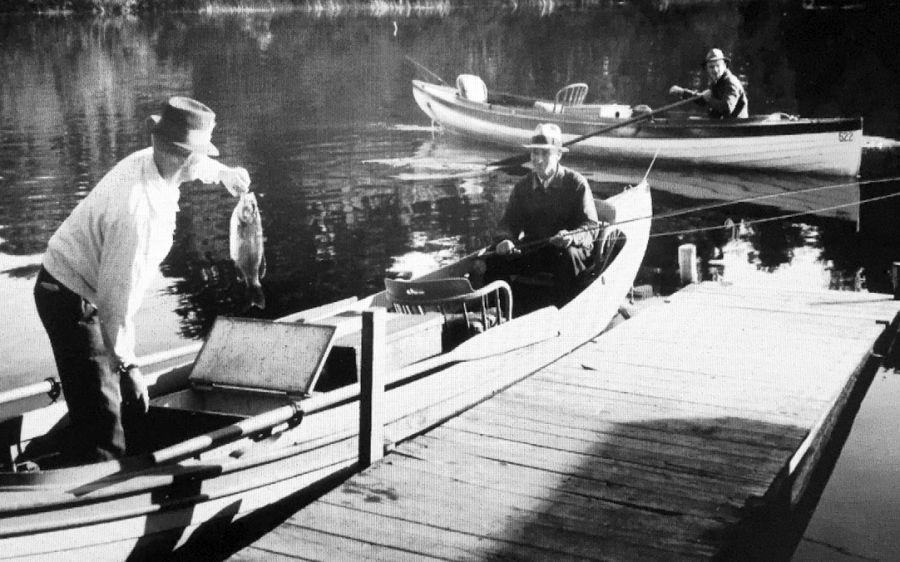
Fishin’ with Charles, Part I

Belgrade Lakes, August 1, 1939 — It is 6:05 a.m. and the sun has just crept over the horizon to the east. Vivid red streaks showed through the trees, promising a steaming hot day ahead. The old adage, “Red sky in the morning, sailors take warning,” comes into the mind of Belgrade fishing guide Charles Brown, as he steps outside of his granite house in Belgrade Lakes village. He will have to watch the sky today and be extra vigilant, as thunderstorms are likely this time of year. Getting caught out on the lake in a bad storm with sports on board, is not only dangerous but embarrassing, and likely to affect the tip they might pass on to him after the day of fishing.
Charles returns to his house for breakfast and will then prepare to meet his charges at 9:00 a.m. at the Association docks. These are located across the street on Mill Stream and are shared by most of the local guides. His 1919, 24-foot, Stewart-built guide boat is berthed there along with others. The docks are behind the Damren and Pulsifer houses, accessed by a dirt path from Main street between Damren’s barn and the Harden tackle store.
Albert and Blanche Rau had arrived at Belgrade Depot train station yesterday from New York City. This was their fifth year in a row of coming to the Belgrades, and after the long train trip, both were anxious to get settled in at The Manor, Ed and Clara Megill’s large home with bed and breakfast. They would spend the next month there enjoying good country food including white perch, and the hospitality of Ed and Clara.
The Megills also own the Locust House, a larger building across the street on the Mill Stream side, with rooms and a dining hall where all patrons from both places dine. There had been other options of places to stay five years ago when they first came, such as the Belgrade Hotel, The Lakeshore and others, but the Manor’s accommodations were wonderful, and a feeling of family had developed.
After being taxied from the Depot to Belgrade Lakes by a local woman named Sadie Yeaton, Ed and Clara had graciously welcomed them back and led them to the upper room facing West, with great views over Long Pond, and they had their own bath. They rested at ease that their luggage from the train, two medium size trunks, would arrive in an hour or two by Model A Ford truck. Tillson’s garage just up the street had been offering that service for years and hired local men, often guides, to drive. In the earlier years, Stanley Steamers were the vehicle of choice.
Back at the stone house, guide Charles continued to do his chores and prepare for the day of fishing with the Raus on board. In addition to giving his guideboat a good visual checkover, he added some gasoline to the 10 gallon, copper tank, checked the engine oil and sponged out the bilge.
After his boat looked shipshape, Charles walked down the street with his empty frogbox to meet baitman Cassie French. Cassie was the main bait supplier for most fishing guides in the area. Each came to Cassie’s spot where he parked his old truck every morning, just across from Bartlett’s store. His offerings varied, but the mainstay of popular baits were worms (crawlers), crawfish, frogs and hellgrammites (Dobson fly larvae).
After morning greetings with Cassie and purchasing a full compliment of bait, Charles walked back up street with loaded bait box in hand, then down the dirt alley to his waiting craft. The Raus arrived soon after along with a few other sports who came to meet their guides, namely Fred Ellis, Merle Rix, and Ernest Johnson.
After some short pleasantries, Charles directed Blanche and Albert to their respective “chairs” in the boat. Seating for paying sports had seatbacks much like a lawn chair and were not only comfortable, but placed in such a way to allow the guide/captain to operate the boat’s inboard motor, row the oars and put bait on both lines. Most sports did not bait their own hooks, nor handle the fish when caught.
After the seating was done, Charles cast off the two dock lines, pushed the boat gently out and spryly stepped on the gunnel as he slipped into the seat where oars awaited. Due to the vintage of the Stewart-built guide boat, it was not equipped with a reverse gear or neutral. Later models did include those features, but Charles had decided to nurture his old boat until he retired. He rowed the boat backwards well away from the slip, and using one oar forward and one back he slowly turned the 24 footer until the bow was headed out the stream towards Great Pond.
With what seemed like little or no effort, he set the very lengthy oars on the wide rails and quickly squirted a thimble full of gasoline into the primer cup. With the other hand, he deftly turned the magneto kill switch to open, firmly gripped the crank handle and pulled upward. The big flywheel of the 2 cylinder Kermath engine rolled over and POP, POP, POP, the boat slowly slithered out through the Mill Stream narrows and into Great Pond. The fishing day had begun.
Stay tuned next week to catch some fish on Great Pond and enjoy a nice lunch on Oak Island!
Rod Johnson was born and raised in the Belgrade Lakes in the 1950s and ’60s.
Download Full Newspaper: High Res | Low Res (Details…)
<— Previous Article • Summaries • Next Article —>
©2022 by Summertime in the Belgrades. All rights reserved.